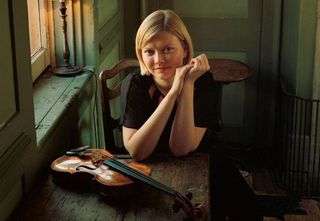|
Back
Bach, Brahms, Schumann - and Cage Toronto
Koerner Hall
03/31/2017 -
Johann Sebastian Bach: Violin Sonata No. 4 in C Minor, BWV 1017
Johannes Brahms: Violin Sonata No. 2 in A Major, Op. 100
John Cage: Six Melodies
Robert Schumann: Violin Sonata No. 2 in D Minor, Op. 121
Alina Ibragimova (violin), Cédric Tiberghien (piano) 
A. Ibragimova (© Eva Vermandel)
This recital by frequent partners violinist Alina Ibragimova (born in Russia, trained in the UK) and French pianist Cédric Tiberghien featured three contrasting styles of playing.
Considered retrospectively, their approach to Bach’s Violin Sonata No. 4 had the only questionable results in the program. In the opening Siciliano (which anticipates the introductory music in the St. Matthew Passion) there was a tendency for the piano to overshadow the violin. The pianist seems meant to dominate the second movement, while the intertwined lines of the third movement (Adagio) were nicely worked out, as was the racy concluding Allegro. One doesn’t want Bach to be over-romanticised, but compared with the rest of the program, the chosen approach was detached to a mannered degree.
Johannes Brahms’ Violin Sonata No. 2 was composed more than 150 years after Bach’s work and was played (most appropriately) with a much darker, warmer sound. The second movement (Andante tranquillo) is largely ruminative, but it has a jaunty, dancing conclusion that sparked a round of applause. (I normally frown upon applause during a work, but this time it was fully justified.) The final movement had richness and grandeur. A memorable performance overall.
John Cage’s Six Melodies, composed in 1950, could well be called “almost melodies”. It is as if he composed some pleasant little pieces then rubbed out some of the notes, leaving spasmodic shards to be played laconically, without vibrato. Given such sparse material it is remarkable how each section expresses a distinctive mood. Despite its terseness it received a rather surprising degree of audience approval.
The concluding work, Schumann’s Violin Sonata No. 2 of 1851, has all the declarative presence of a big ultra-romantic concerto, and here again the duo adopted their full romantic tone. It is not all Sturm und Drang, though, what with a very intimate section in the opening movement, and a stately stretch in the third movement leading to an introspective meditation. The energetic, roiling conclusion brought the audience to its feet.
The encore was a soulful arrangement of Schumann’s “Abendlied”.
Michael Johnson
|